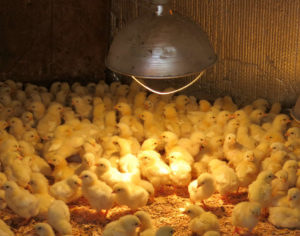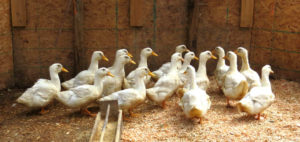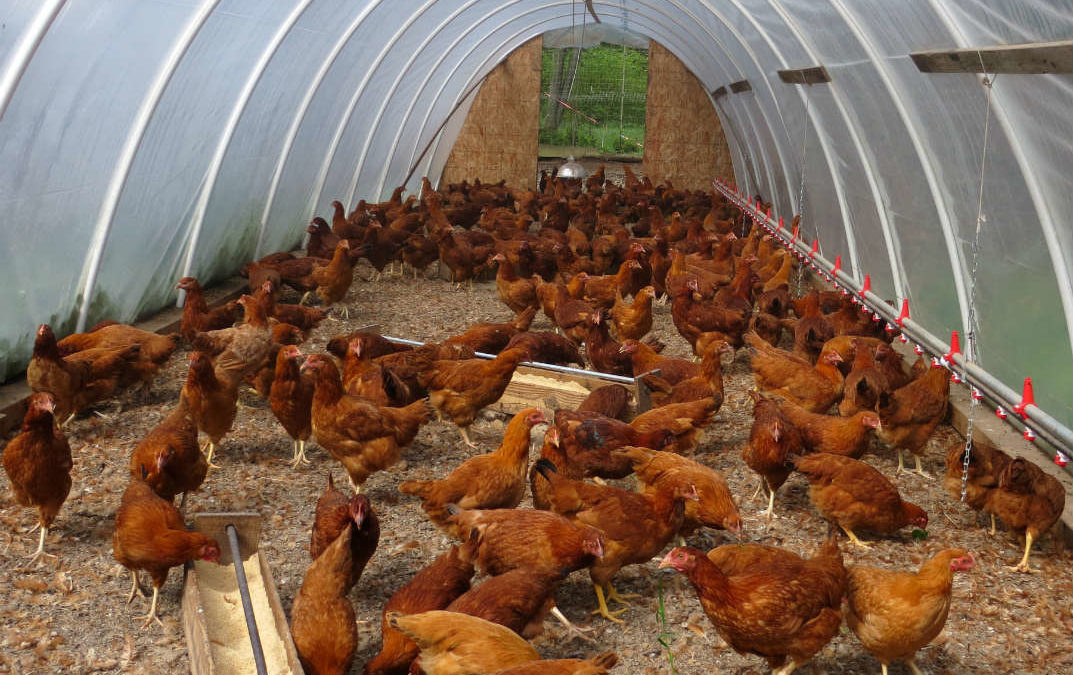“The Seahawks are fueled by the Stokesberry’s eggs and chickens!” Piquing my 16-year old daughter’s interest in organic, sustainable farming was impossible until the 2014 Super Bowl champs were involved. Jerry and Janelle Stokesberry are an unassuming farming couple providing superb meat and egg products for the Seattle Seahawks, and for discerning palettes at restaurants and wise shoppers at farmer markets.
Farm to Team
How do the Stokesberrys supply fresh organically grown chickens and 60 dozen eggs a week to stoke the Seahawks?
 In late May, I spent time on the farm learning about their operation, collecting eggs, cuddling a baby chick, and feeding the chickens destined for the barbeque. Observing the farm rhythm, helped me appreciate the demands and determination that it takes to create a bountiful food abundance not only for the Super Bowl team, but for all their customers. Eaters who care about where and how their food is grown are grateful for the attention the Stokesberrys put into raising their animals.
In late May, I spent time on the farm learning about their operation, collecting eggs, cuddling a baby chick, and feeding the chickens destined for the barbeque. Observing the farm rhythm, helped me appreciate the demands and determination that it takes to create a bountiful food abundance not only for the Super Bowl team, but for all their customers. Eaters who care about where and how their food is grown are grateful for the attention the Stokesberrys put into raising their animals.
Thankfully, all of the animals have adequate space to roam and enjoy life, until they are processed for the dinner table. Unlike the mainstream meat production system, there are no animals confined to cages or living in isolation. All the animals are fed their natural diets, making healthy protein products for humans.
The Home Farm
Stokesberry Sustainable Farm is tucked away in semi-rural Thurston County, just minutes from the I-5 thoroughfare, the bustle of modern living, and State’s political epicenter. The Stokesberrys had a only short time for a visit, as they along with their two full-time workers had many daily chores to accomplish, orders to fill, and paperwork to complete.
First stop was the Red-Sex Link chicken hoop houses. Red-Sex Link chickens are bred for their incredible egg laying ability at 265 to 300 eggs per hen per year and just as importantly different feather colors between the sexes. Roosters not only crow at break of dawn, but anytime they want to, so quickly become chicken soup, since the neighbors are ungrateful for the noise. Many jurisdictions outlaw roosters, since they disturb the peace. With the differentiated colored Red-Sex Link poultry, the roosters can be quickly culled leaving only egg producers.
The Stokesberrys do not raise their layers from eggs, but rather purchase hatched chicks, which upon arrival are immediately housed under heat lamps and soon after moved to larger quarters. Once five months old they are moved to the hen house, where laying begins. Happy chickens clucked around my legs, as I reached inside the hen boxes for the warm containers of compact protein. Five hundred dozen eggs, equating to 6,000 individual eggs, are harvested from the hens weekly with 12% of their yield being Seahawk nourishment.
 Next stop was the duck house. Duck eggs are popular because of higher fat content and consequently more flavor than chicken eggs. Those allergic to chicken eggs, can often eat the alkaline duck eggs which lack a particular protein that is found in the acidic chicken eggs. Duck eggs are larger and have a noticeably tougher shell, which gives them a longer refrigerated shelf life, too. The ducks were content in their pen waddling around in a tight group.
Next stop was the duck house. Duck eggs are popular because of higher fat content and consequently more flavor than chicken eggs. Those allergic to chicken eggs, can often eat the alkaline duck eggs which lack a particular protein that is found in the acidic chicken eggs. Duck eggs are larger and have a noticeably tougher shell, which gives them a longer refrigerated shelf life, too. The ducks were content in their pen waddling around in a tight group.
The home farm has multiple hoop houses for chickens and ducks and a small area for pigs. Bob, the boar (male pig) is housed by himself in an open air pen, as the sows adjacent to Bob were tending a drift of piglets.
The Pasture
A 20-minute pastoral drive away, the Stokesberry’s lease eleven acres of pasture where they raise several cattle, a small herd of sheep, and meat chickens! The meat chickens are raised for slaughter and are actually ugly, since they have a scrawny feather coat. Fewer feathers makes for easy plucking! Upon arrival, five chickens were wandering outside their chicken tractor, having escaped through a hole and trying to figure out how to get back in. Chickens are not loners, but prefer hanging out with their brethren, and don’t often wander off.
Now, “What is a chicken tractor?”
A chicken tractor is just over a foot high, 12-foot square wood framed home with no bottom, covered with wire mesh sides and corrugated metal roof, designed so the chickens are not attacked by predators, protected from the rain, and still able to see their surroundings. About 100 Cornish Cross meater chickens live beneath each tractor, pecking at the dirt for grubs, bugs, seeds and other delectables. Every day two people must visit the pasture to refill the grain troughs and move the tractor, since the grass is matted and mottled from the chicken excrement.
Moving the tractor takes about 10 minutes. First the lid is removed enabling the grain troughs to be refilled. The forward end of the tractor is lifted with a dolly, and two–four inch diameter pipes are placed beneath the frame on the forward part of the tractor. Two people push the back end of the wood structure forward rolling over the pipes, until the chicken home has moved one tractor length. The chickens walk quickly ahead while the tractor advances, because they know the grass will be greener and filled with more morsels than the day-old ground they are leaving. As the urban gardener knows chicken manure is a primo fertilizer. By the time the next brood of chickens is returned to this portion of the pasture, the grass will be green again.
The final chore of my visit was to relocate the electric fence to move the cattle to greener pastures. As with the chickens the cattle are regularly moved to ensure that the animals always have superb grass to eat and don’t over-graze or over-fertilize the field.
The Stokesberrys attentively tend their animals and business such that the Seahawks’ chef, Mac McNabb knows he is getting premium product for the best football team in the country. Now, what Seahawk can only eat duck eggs, rather than chicken eggs? My daughter knows!
Kathryn Gardow, P.E., is a local food advocate, land use expert and owner of Gardow Consulting, an organization dedicated to providing multidisciplinary solutions to building sustainable communities. Kathryn has expertise in project management, planning, and civil engineering, with an emphasis on creating communities that include food production. Kathryn is a Washington Sustainable Food and Farming Network board member. Kathryn’s blog muses on ways to create a more sustainable world.


Lovely story – Jerry and Janelle do great work at Stokesberry Farms!
Thanks so much!